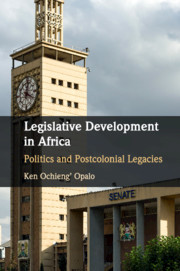Book contents
- Frontmatter
- Dedication
- Contents
- List of Figures
- List of Tables
- Preface
- Acknowledgements
- 1 Introduction
- 2 Legislative Development in Africa
- 3 Intra-Elite Politics and Credible Commitment
- 4 Colonial Origins of Parliaments in Kenya and Zambia
- 5 Elite Control and Legislative Development
- 6 Legislative Institutionalization in Time
- 7 Electoral Politics and Legislative Independence
- 8 Conclusion
- References
- Index
6 - Legislative Institutionalization in Time
Published online by Cambridge University Press: 17 June 2019
- Frontmatter
- Dedication
- Contents
- List of Figures
- List of Tables
- Preface
- Acknowledgements
- 1 Introduction
- 2 Legislative Development in Africa
- 3 Intra-Elite Politics and Credible Commitment
- 4 Colonial Origins of Parliaments in Kenya and Zambia
- 5 Elite Control and Legislative Development
- 6 Legislative Institutionalization in Time
- 7 Electoral Politics and Legislative Independence
- 8 Conclusion
- References
- Index
Summary
This chapter examines legislative development in Kenya and Zambia over time by documenting the longitudinal variation in four key measures of legislative institutionalization and independence – the number of sittings per year, the share of the budget allocated to legislatures, remuneration of legislators, the share of executive bills passed in the legislature, and the incidence of executive rule-making. An examination of these specific measures provides evidence of the differences in legislative development in Kenya and Zambia as predicted by the previous two chapters. First, because of its relative lack of independence, on average Zambia’s legislature met fewer times (even as it handled more bills) than its Kenyan counterpart. It also passed executive bills at higher rates than Kenya’s legislature. Second, following the end of single-party rule, Kenya’s legislature emerged from the shadow of KANU stronger than its Zambian counterpart did following the demise of UNIP. After 1991 rates of passage of executive bills dropped precipitously in Kenya but not in Zambia. Kenyan legislators were also better able to exploit their newfound independence and increased bargaining power to obtain a bigger share of the budget, increase their level of remuneration, and to limit the incidence of unilateral executive rule-making.
- Type
- Chapter
- Information
- Legislative Development in AfricaPolitics and Postcolonial Legacies, pp. 179 - 207Publisher: Cambridge University PressPrint publication year: 2019



